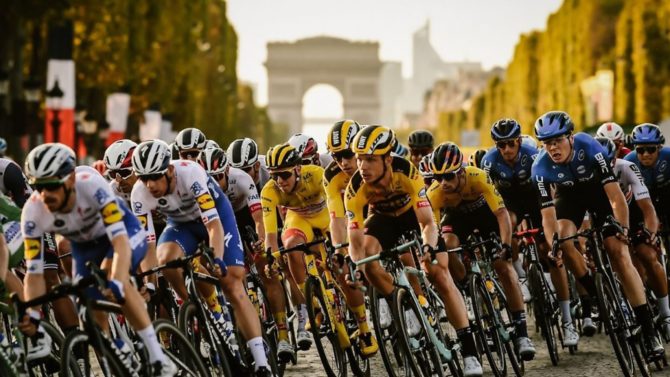Everything you need to know about the Tour de France 2021
The world-famous cycle race is back for 2021, despite the ongoing coronavirus situation – find out more about this year’s route and stages, the cyclists to watch, how to watch it and much more

The French cycling spectacular, the Tour de France, is back for 2021, less than a year after the 2020 race went ahead against all odds.
What happened in the 2020 Tour de France?
In mid-April 2020, President Macron banned large-scale public events in France to try and combat the spread of Covid-19 during the first wave of the virus. It meant La Grande Boucle, as it’s known among fans, had to be postponed from its scheduled dates of 27 June to 19 July to 29 August to 20 September.

The 2020 route began in Nice, with various stages across the south-east and the central-west of France, the Pyrenees, the Massif Central, and as usual the finish line was at the Champs-Élysées in Paris. For riders and spectators alike, it was a very different year, as race director Christian Prudhomme explained in an interview to Spanish newspaper El Periódico. “There will surely be no kisses or hugs during official ceremonies. And one might think that it is certainly not the best year to collect autographs. The public may come to the Tour but there will be a filter.”
The young Slovene Tadej Poga?ar was victorious in the 2020 Tour and his fellow countryman Primož Rogli? was runner-up.

Which cyclists should I watch out for in the 2021 Tour de France?
Both Poga?ar and Rogli? are expected to be strong contenders in the 2021 edition of the race. Cycling News also rank Mikel Landa from the Bahrain Victorius team and Bauke Mollema of Trek-Segafredo. Previous winners Geraint Thomas and Chris Froome will also be returning to the Tour this year.

When will the 2021 Tour de France take place?
If everything goes to plan, the 2021 race will run from 26 June to 18 July. The exciting features include three summit finishes, a double appearance in one stage from the magnificent Mont Ventoux, and the return of the first-week individual time trial.

What is the route of the Tour de France in 2021?
Here’s a quick stage-by-stage guide to the 2021 race, from the Grand Départ in Brest to the final stage in Paris.
Stage 1, 26 June: Brest to Landerneau (187km)
The race was set to depart from Copenhagen in Denmark but due to scheduling conflicts, the Danish start has been postponed until 2022. The Finistère port city of Brest has instead stepped into the spotlight for the Grand Départ. This hilly stage will south pass through Breton honeypots like Locronan and Quimper, before heading back north via the Monts the d’Arrée.
Stage 2, 27 June: Perros-Guirec to Mûr-de-Bretagne– Guerlédan (182km)
Today’s circuit is a chance to explore the gorgeous Pink Granite Coast of northern Brittany before the peloton heads south via the hilly Côte de Mûr-de-Bretagne, with a great climb into the destination village.
Stage 3, 28 June: Lorient to Pontivy (182km)
Morbihan’s fantastic scenery is in the spotlight today. Sprinters will relish the route near the 15th-century Château des Rohan near the end.
Stage 4, 29 June: Redon to Fougères (152km)
The Tour heads inland to Brittany’s Argoat region. It’s an undulating stage heading north-east through Ille-et-Vilaine. Redon is known for its festival of Breton culture, the Bogue d’Or, taking place every October.
Stage 5, 30 June: Changé to Laval Espace Mayenne (27km)
Time trial time! It’s the longest individual time trial since 2008 and what’s more, it’s Changé’s first appearance in the Tour. Just north of Laval, the town is divided by the River Mayenne.
Stage 6, 1 July: Tours to Châteauroux (144km)
The Loire Valley’s rich heritage will be on display in this picturesque stage. It’s Châteauroux’s first appearance in the Tour since 2011.
Stage 7, 2 July: Vierzon to Le Creusot (248km)
Vierzon is another new addition to the Tour – the town was immortalised in Jacques Brel’s song Vesoul. Another newcomer, the Signal d’Uchon in the Morvan mountains, will prove a challenging ascent towards the end.
Stage 8, 3 July: Oyonnax to Le Grand-Bornand (151km)
Over to the Alps where the climbers of the race will shine up the Cols de Romme and de la Colombière. Then it’s a final descent into the pretty ski resort of Le Grand-Bornand in the Aravis mountains.
Stage 9, 4 July: Cluses to Tignes (145km)
After a disappointing miss in 2019, when the stage ending in Tignes was aborted due to violent storms and landslides, the Tour is back for another shot. The route passes through other idyllic Alpine locations like Megève and Beaufort, heartland of the famous cheese.
Stage 10, 6 July: Albertville to Valence (186km)
After a rest day in Tignes, the race will resume in the Winter Olympic host city of Albertville, before exploring the Isère and Rhône Valleys.
Stage 11, 7 July: Sorgues to Malaucène (199km)
The fearsome Mont Ventoux, the so-called Beast of Provence, makes a double appearance in today’s stage. Other Provençal tourist spots making an appearance include the colourful village of Rousillon and the antiques capital of L’Isle sur la Sorgue.
Stage 12, 8 July: Saint-Paul-Trois-Châteaux to Nîmes (161km)
The Tour will visit the Gorges de l’Ardèche, known as Europe’s own version of the Grand Canyon, for the first time.
Stage 13, 9 July: Nîmes to Carcassonne (220km)
A race between two of France’s most historic cities – the Roman city of Nîmes to Carcassonne, renowned across the world for its fortress.
Stage 14, 10 July: Carcassonne to Quillan (184km)
The riders will advance into the Pyrenees, tackling climbs like the Col de la Croix des Morts and the Col de Montségur.
Stage 15, 11 July: Céret to Andorre-la-Vieille (192km)
After the first stop in Pyrénées-Orientales since 2019, today’s race will end in the principality of Andorra. Today also features the highest point of the race, the Port d’Envalira. The first rider to the top will get the Souvenir Henri Desgrange.
Stage 16, 13 July: Pas de la Case to Saint-Gaudens (169km)
Rejuvenated after a rest day in Andorra, the riders will face a hilly stage ending in the pretty old town of Saint-Gaudens in Haute-Garonne.
Stage 17, 14 July: Muret to Saint-Lary-Soulan Col du Portet (178km)
It’s the race’s Bastille Day edition with three challenging climbs: the Cols du Peyresourde, de Val Louron-Azet and du Portet to finish the day.
Stage 18, 15 July: Pau to Luz Ardiden (130km)
The last mountain stage will first tackle the foothills of the Pyrenees before facing a giant of the race, the Col du Tourmalet, making its 85th appearance.
Stage 19, 16 July: Mourenx to Libourne (203km)
The flat Landes stage sees the riders head north to northern Gironde’s wine-making capital, Libourne.
Stage 20, 17 July: Libourne to Saint-Emilion (31km)
The second time trial is set among Gironde’s gorgeous vineyard scenery.
Stage 21, 18 July: Chatou to Paris (112km)
Yvelines, home to Chatou, will be hosting the cycling events for the 2024 Paris Olympics, so it seems fitting that it should welcome the Tour on its final day. Who will be crowned champion?
How can I watch the Tour de France on TV?
To be confirmed nearer the time.
____________________________________________________________________________________________________________________________________________________________________________________________________________________________________________
You might also like…
Tale of two wheels: Is France cycling more than ever?
Vive la véloroute! Buy a French property close to a family-friendly cycle path
Share to: Facebook Twitter LinkedIn Email




